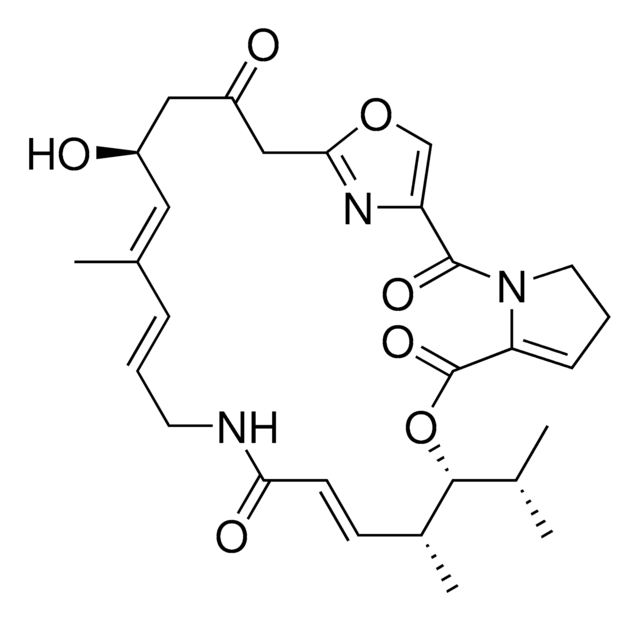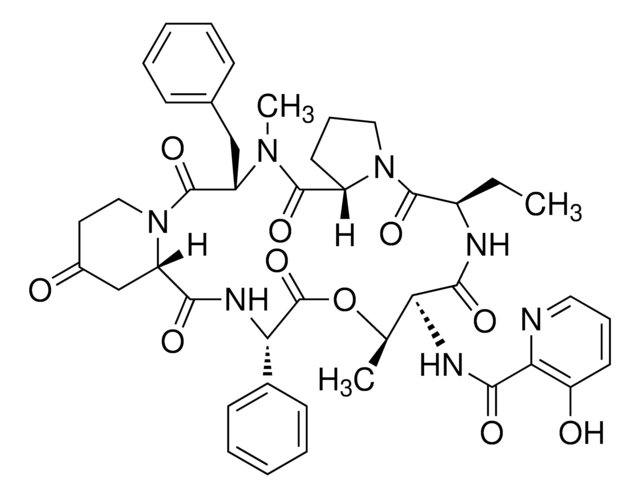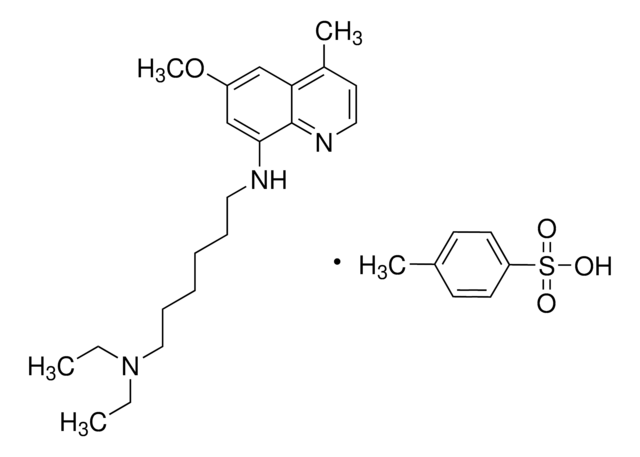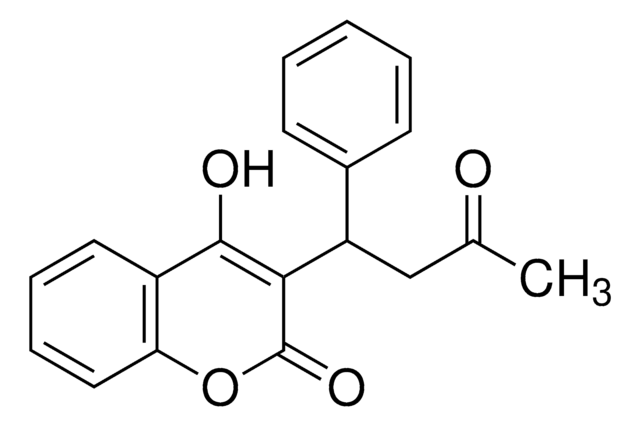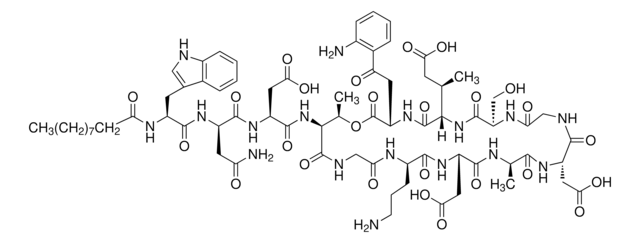Wichtige Dokumente
SBR00044
Pristinamycin
≥98% (Assay)
Synonym(e):
Pristinamycine
About This Item
Empfohlene Produkte
Qualitätsniveau
Assay
≥98% (Assay)
Form
powder
Farbe
white to faint yellow
Wirkungsspektrum von Antibiotika
Gram-positive bacteria
Wirkungsweise
protein synthesis | inhibits
Lagertemp.
2-8°C
SMILES String
CN(C)C1=CC=C(C[C@@H](C(N2CCC(C[C@H]2C(N[C@@H](C3=CC=CC=C3)C(O[C@H](C)[C@H](NC(C4=NC=CC=C4O)=O)C5=O)=O)=O)=O)=O)N(C)C([C@H]6N(C([C@@H](N5)CC)=O)CCC6)=O)C=C1.O=C(N7C(C(O[C@H](C(C)C)[C@H](C)/C=C/C(NC/C=C/C(C)=C/[C@@H](O)CC(C8)=O)=O)=O)=CCC7)C9=COC8=N9
InChI
1S/C45H54N8O10.C28H35N3O7/c1-6-31-42(59)52-22-11-14-32(52)43(60)51(5)34(24-27-16-18-29(19-17-27)50(3)4)44(61)53-23-20-30(54)25-33(53)39(56)49-37(28-12-8-7-9-13-28)45(62)63-26(2)36(40(57)47-31)48-41(58)38-35(55)15-10-21-46-38;1-17(2)26-19(4)9-10-24(34)29-1
InChIKey
YVMBAUWDIGJRNY-OOVQIFRISA-N
Allgemeine Beschreibung
Anwendung
- in cloning and sequencing of genes involved in the biosynthesis of the depsipeptide antibiotics pristinamycins I (PI) produced by Streptomyces pristinaespiralis
- in a study on inducible gene expression system in mycobacteria
Biochem./physiol. Wirkung
- Inhibition of protein synthesis: Pristinamycin binds to the 50S ribosomal subunit in bacterial cells, thereby inhibiting the formation of peptide bonds during protein synthesis. This disrupts the translation process and prevents the production of essential proteins necessary for bacterial growth and survival.
- Interference with cell wall synthesis: Pristinamycin also interferes with the synthesis of bacterial cell walls. It inhibits the transpeptidation step of peptidoglycan biosynthesis, which is essential for the cross-linking of cell wall components. This leads to the weakening of the bacterial cell wall and eventual cell lysis
Activity spectrum: Pristinamycin shows anti-bacterial activity against Gram-positive bacteria like Staphylococcus spp. and Streptococcus spp. Pristinamycin displays antimicrobial activity against macrolide-resistant Mycoplasma genitalium infection.
Leistungsmerkmale und Vorteile
- Broad-spectrum activity: Pristinamycin is effective against a wide range of bacteria, including both Gram-positive and Gram-negative bacteria, as well as resistant strains.
- Synergistic effect: The two components of pristinamycin work together to produce a synergistic effect, meaning that they are more effective together than they are individually.
- Versatility: Pristinamycin can be used in Cell Biology and Biochemical applications
Sonstige Hinweise
Lagerklassenschlüssel
11 - Combustible Solids
WGK
WGK 3
Flammpunkt (°F)
Not applicable
Flammpunkt (°C)
Not applicable
Hier finden Sie alle aktuellen Versionen:
Analysenzertifikate (COA)
It looks like we've run into a problem, but you can still download Certificates of Analysis from our Dokumente section.
Wenn Sie Hilfe benötigen, wenden Sie sich bitte an Kundensupport
Besitzen Sie dieses Produkt bereits?
In der Dokumentenbibliothek finden Sie die Dokumentation zu den Produkten, die Sie kürzlich erworben haben.
Unser Team von Wissenschaftlern verfügt über Erfahrung in allen Forschungsbereichen einschließlich Life Science, Materialwissenschaften, chemischer Synthese, Chromatographie, Analytik und vielen mehr..
Setzen Sie sich mit dem technischen Dienst in Verbindung.